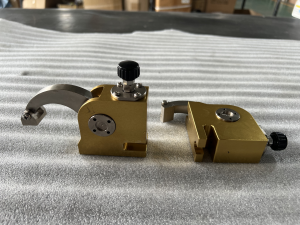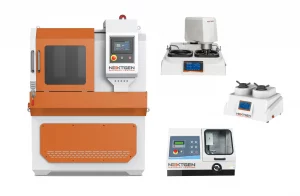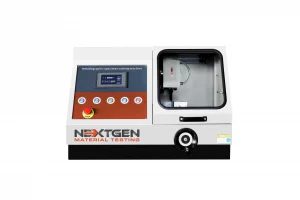Consider the situation where an engineer is tasked with verifying the structural integrity of a newly created aircraft component. The selected metal alloy is well known for its strength and durability; however, verifying its compliance with stringent safety standards is imperative. This verification process is deeply rooted in metallography, which examines metal microstructure to assess their properties and performance.
Metallography is fundamentally the precise preparation of samples, with cutting being the initial and critical step. This process is not merely a mechanical action; it serves as the gateway to understanding internal characteristics. A precise cut preserves the authentic microstructure, facilitating accurate analysis. Conversely, improper cutting techniques can introduce artifacts, leading to misinterpretations and engineering failures.
For individuals embarking on metallographic sample cutting, comprehending the significance of this process is a necessity. Each cut contributes to making sure that materials used in different applications—from infrastructure to transportation—are both safe and dependable.
In this article, we will explore all the key aspects of metallographic sample cutting for beginners.
Understanding Metallographic Cutting
Metallographic cutting, or sectioning, is the process of precisely cutting material into smaller specimens for microscopic examination. The goal is to obtain a clean, undistorted sample that accurately represents the material’s internal structure. This step is an important one in metallography, as it makes certain that the microstructure remains intact for further preparation stages like mounting, grinding, polishing, and etching.
This process is performed using specialized cutting machines equipped with abrasive wheels, diamond blades, or precision saws, depending on the material type. To maintain accuracy, metallographic cutting requires controlled speed, pressure, and proper cooling to prevent structural changes. Coolants and lubricants reduce heat and remove cutting debris, resulting in a smooth and precise cut.
Metallographic cutting is a commonly used technique in material science, metallurgy, and quality control, allowing researchers and engineers to analyze the composition, defects, and mechanical properties of metals, alloys, and composites. Proper cutting techniques are crucial to reliable outcomes in industrial applications, failure analysis, and research and development.
Key Considerations in Metallographic Cutting
Achieving a precise and undistorted sample in metallographic cutting requires careful control over a number of factors. The choice of cutting method, abrasive materials, cooling techniques, and clamping methods all play a crucial role in ensuring a clean section without unwanted structural changes. The following are the key factors that impact metallographic cutting quality and accuracy.
Selection of Cutting Method
Different cutting methods are available depending on the material type and precision level required. One of the most commonly used techniques is abrasive wet cutting, which utilizes a high-speed rotating cut-off wheel with embedded abrasive particles. The process is assisted by continuous coolant flow to prevent overheating and remove cutting debris. The method is highly efficient and minimizes structural damage, making it ideal for a variety of metallic and composite materials.
Choice of Abrasive Cut-Off Wheels
The selection of the appropriate cutting wheel is crucial for a clean cut. Aluminum oxide wheels are commonly used for ferrous metals such as steel and iron, while silicon carbide wheels are better suited to non-ferrous materials like aluminum and copper. The abrasive material, bonding type, and wheel hardness should be matched to the specimen’s properties to minimize cutting resistance and maximize precision.
Cooling and Lubrication
Effective cooling is necessary to dissipate heat generated during cutting, preventing thermal damage and microstructural alterations. Coolants and lubricants control temperature and help clear away cutting debris, improving the cutting wheel’s longevity and guaranteeing a smooth finish. Without adequate cooling, overheating can lead to unwanted phase changes, material softening, or surface hardening, all of which compromise metallographic analysis.
Cutting Techniques
The approach used during cutting significantly affects the final quality of the specimen.
-
Chop cutting involves feeding the rotating cut-off wheel directly into the stationary specimen. This method is effective for smaller samples but may generate excessive heat if not properly controlled.
-
Pulse cutting introduces brief pauses during the chop cut, allowing the blade to cool and reducing overall deformation. This technique also enhances coolant penetration, further protecting the sample from heat damage.
-
Planar cutting takes a different approach by making multiple shallow passes through the material, reducing the contact area and improving cutting precision. This method is particularly useful for larger or more delicate specimens that require minimal mechanical stress.
Clamping and Fixturing
Proper stabilization of the specimen is necessary in order to prevent movement during cutting, which can lead to uneven surfaces, excessive material loss, or unwanted structural defects. Mechanical vises, vacuum holders, and magnetic fixtures are commonly used to secure samples in place, assuring controlled and precise cutting. The choice of clamping method should accommodate the specimen’s shape and material properties to avoid unnecessary pressure or distortion.

Minimizing Deformation and Damage
To accurately represent a material’s microstructure, it is important to minimize mechanical deformation. This is achieved by carefully adjusting cutting parameters such as feed rate, rotational speed, and cutting mode. Excessive force or speed can introduce residual stresses, microcracks, or smearing, while a well-regulated cutting process allows that the specimen remains in its original condition for further metallographic examination.
Step-by-Step Guide to Making a Proper Metallographic Cut
Before making a metallographic cut, you should plan ahead and apply the key considerations discussed earlier. Choosing the right cutting method, selecting an appropriate abrasive wheel, making certain of proper cooling, and securing the sample are all needed steps before starting the actual cut. Once these factors are in place, follow these steps to achieve a precise and undistorted section.
Step 1: Prepare the Work Area and Equipment
Start by verifying that the cutting machine is properly set up. The correct cutting wheel should be installed based on the material type. Make sure the coolant system is filled and functioning properly. The sample should be clean and free of debris before cutting to prevent contamination.
Step 2: Secure the Sample Properly
Clamping the specimen correctly is a crucial component to a uniform cut. Select the appropriate fixture, such as a mechanical vise, magnetic holder, or vacuum fixture, to keep the sample stable. Ascertain that the sample is positioned in a way that allows for an efficient and precise cut without unnecessary pressure.
Step 3: Adjust Cutting Parameters
Before starting, set the appropriate feed rate and cutting speed. These parameters should be adjusted based on the material’s hardness and the type of cutting wheel used. Avoid excessive force to prevent deformation or microstructural damage. If necessary, refer to the cutting machine’s guidelines for recommended speed and pressure settings.
Step 4: Start the Cutting Process with a Steady Motion
Begin the cutting process with smooth and controlled movement. Avoid sudden force or rapid feed rates, as these can lead to excessive heat generation and material distortion. If needed, apply techniques such as chop cutting, pulse cutting, or planar cutting, depending on the specimen size and precision required.
Step 5: Monitor Cooling and Lubrication
Throughout the cutting process, make certain that coolant is applied evenly to the cutting zone. This helps to regulate the temperature, remove cutting debris, and extend cutting wheel life. If signs of overheating, discoloration, or excessive wear appear, pause the process and check the coolant flow.
Step 6: Inspect the Cut Quality
Once the cut is complete, inspect the sample for defects such as burn marks, uneven edges, or deformation. If necessary, refine the cutting parameters and repeat the process for improved accuracy. The goal is to obtain a clean, undistorted section ready for the next preparation stage.
Types of Metallographic Cutting Equipment
 The choice of machine depends on the material type, required accuracy, and preparation volume. Below are the main types of metallographic cutting equipment.
The choice of machine depends on the material type, required accuracy, and preparation volume. Below are the main types of metallographic cutting equipment.
Abrasive cut-off machines are the most commonly used for cutting metals and hard materials. They feature high-speed rotating wheels with abrasive particles, such as aluminum oxide or silicon carbide, and operate with a coolant system to reduce heat. These machines are widely used in laboratories for cutting steel, alloys, and composites. However, they may introduce minor mechanical stresses if not properly controlled.
For more delicate materials requiring high precision and minimal deformation, precision sectioning machines are the preferred option. They operate at lower speeds using diamond or cubic boron nitride (CBN) blades, making them particularly suitable for brittle samples, thin foils, and electronic components. Although slower than abrasive cutters, they provide highly accurate cuts while preserving the original microstructure.
Manual and automatic cut-off machines offer different control levels. Manual machines require operator input to control the feed rate, making them suitable for occasional use in low-volume labs. Automatic systems, on the other hand, optimize speed, pressure, and cooling automatically, resulting in consistency and efficiency for high-throughput applications.
For large or irregularly shaped specimens, band saws and wire saws provide alternative cutting methods. Band saws operate at lower speeds to reduce stress on large metal blocks and castings, while wire saws use diamond-coated wires to produce ultra-precise cuts for fragile materials such as ceramics and composites.
GenCut GL350: The Highest Precision Metallographic Cutting Machine
Accurate sample preparation is the foundation of successful microstructural analysis, and choosing the right cutting equipment will guarantee high-quality results while preserving specimen integrity.
 If you are on the market for a high-performance cutting system that delivers exceptional accuracy, durability, and versatility, the GenCut GL350 is the ideal solution. Designed for precision metallographic cutting, this machine is equipped with both automatic and manual operation modes, allowing users to easily switch between different cutting tasks. Whether you need to cut circular workpieces up to 100mm in diameter or rectangular samples with a depth of up to 200mm, the GenCut GL350 provides superior cutting performance for a wide variety of materials.
If you are on the market for a high-performance cutting system that delivers exceptional accuracy, durability, and versatility, the GenCut GL350 is the ideal solution. Designed for precision metallographic cutting, this machine is equipped with both automatic and manual operation modes, allowing users to easily switch between different cutting tasks. Whether you need to cut circular workpieces up to 100mm in diameter or rectangular samples with a depth of up to 200mm, the GenCut GL350 provides superior cutting performance for a wide variety of materials.
What sets the GenCut GL350 apart is its durable construction and advanced engineering. The system features a powerful 3.3kW motor, a variable-speed spindle ranging from 300 to 3000 rpm, and a precisely adjustable feed speed of 1-40mm/min, allowing full control over the cutting process. To prevent overheating and maximize optimal sample preservation, the integrated cooling system effectively reduces heat buildup, minimizing the risk of tissue burning or microstructural damage.
The Importance of Precision in Metallographic Cutting
Achieving high-quality metallographic samples begins with precise and reliable cutting techniques. The accuracy of this initial step directly impacts the effectiveness of subsequent preparation processes such as grinding, polishing, and etching. A well-engineered cutting system must balance power, speed, and cooling efficiency to provide clean cuts while preserving the material’s microstructure.
Key considerations such as choosing the right cutting method, selecting the appropriate abrasive wheels, and implementing effective cooling and clamping mechanisms play a crucial role in minimizing deformation and ensuring repeatability. Advanced cutting equipment with adjustable feed rates, robust construction, and safety features increase efficiency while maintaining a secure working environment.
Investing in the right cutting solution leads to consistent results, extended equipment lifespan, and optimal sample integrity, supporting high standards in metallurgical and material testing.
If you have any questions or need assistance choosing the right equipment for your material testing, please do not hesitate to contact us directly or request a quotation online. We are here to assist you in making the right decision.